WHAT IS THE LEED AP CERTIFICATION?
PASS THE LEED AP EXAM IN 2 WEEKS – TRUSTED BY 5,000+ STUDENTS
WHAT IS LEED AP
The LEED AP certification is a well recognized credential that showcases a professional’s understanding about green buildings and the LEED certification process. Developers and firms are looking for professionals that hold the LEED Accredited Professional credential to design and execute projects that are both sustainable and can streamline the certification process.
This advanced knowledge a professional holds revolves around energy efficiency, sustainable sites, materials and resources, water efficiency and more. USGBC who developed the LEED accreditation estimates that there are presently more than one million persons who have earned the LEED Accredited Professional certificate. In addition, USGBC forecasts in the upcoming years, almost 2.5 million new buildings will be LEED-certified, increasing the demand for LEED AP professionals.
So what is LEED AP? The LEED AP title signifies LEED Accredited Professional but the true LEED AP meaning is that a professional is credible in the building industry with a focus on sustainability, green buildings and energy performance. Can help the team certify a project applying for LEED and can help the company win more projects using the credible title.
What is the LEED AP BD+C meaning then? It is a professional that knows all requirements, options and calculations for all prerequisites and credits of the BD+C rating system. Which signifies Building Design and Construction, all new construction and major renovation projects are under BD+C and this LEED AP knows how to get this certification rating system. The BD+C is not the only LEED AP with specialty but it is the most in-demand and widely used.
+5,000 OF OUR STUDENTS PASSED THE LEED AP test, it’s your time!

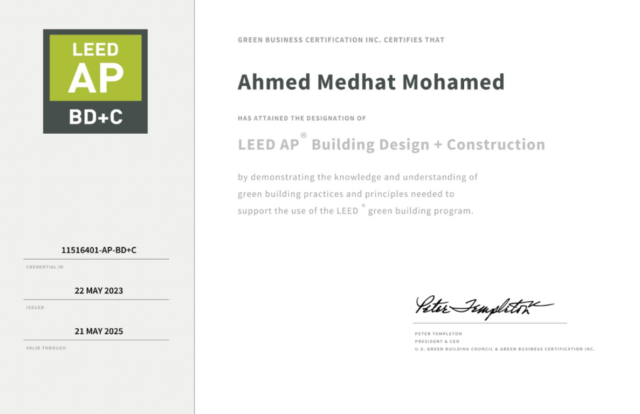
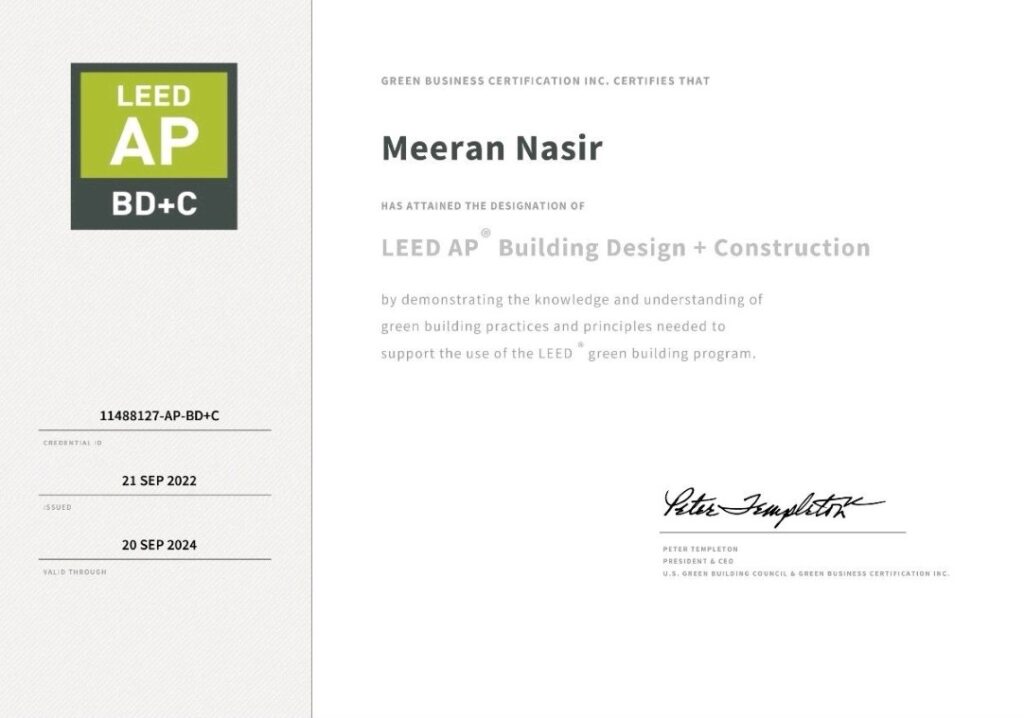
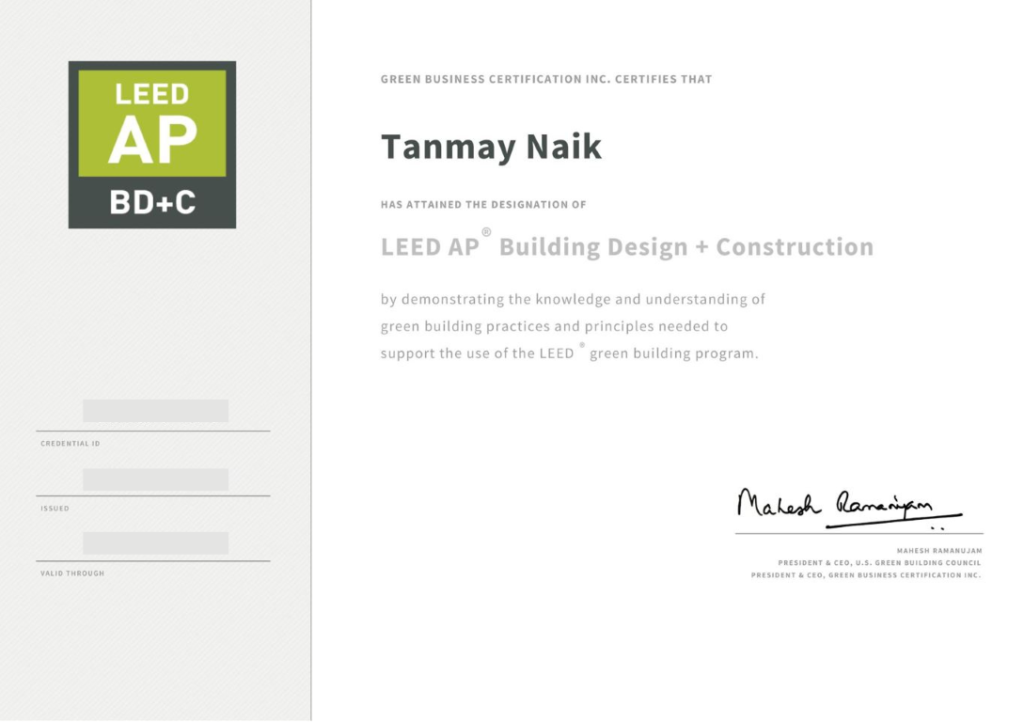
meet your instructor

shadi abousamra
LEED TRAINER, SUSTAINABILITY CONSULTANT, UNIVERSITY PROFESSOR
Shadi AbouSamra is a LEED trainer, consultant and university professor. Specialized in sustainable design, LEED, and high-performance buildings.
He has trained over +5,000 professionals become LEED Green Associates and earn the LEED AP certification. Architects, Mechanical Engineers, Civil Engineers, Interior Designers and almost all stakeholders in the AEC industry.
Students worldwide from USA, UAE, KSA, Canada and many more.
His LEED AP exam preparation guide has simplified the preparation saving professionals their valuable time and money.
FEATURED IN:
COMPANIES & UNIVERSITIES PARTNERED WITH:
COMPANIES & UNIVERSITIES PARTNERED WITH:
WHAT OUR LEED AP CERTIFIED STUDENTS ARE SAYING…
- 35% SALARY HIKE
- Ashraf Shaaban
Project Manager
- 50% SALARY HIKE
- Omar Doughan
Operations Manager
- 47% SALARY HIKE
- Zeina Sawaya
Arch. Consultant
- FIRST JOB
- Linda K.
Junior Architect
- 20% SALARY HIKE
- Daria Taeb
Project Manager
- Ashraf Shaaban
Project Manager
- Omar Doughan
Operations Manager
- Zeina Sawaya
Arch. Consultant

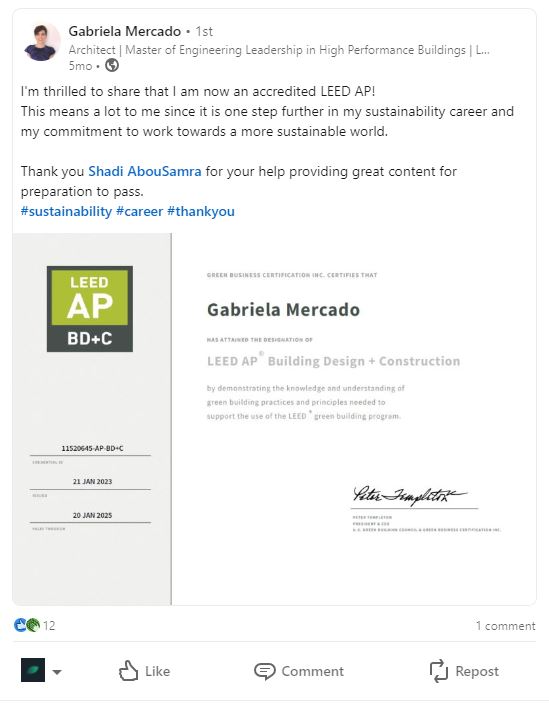
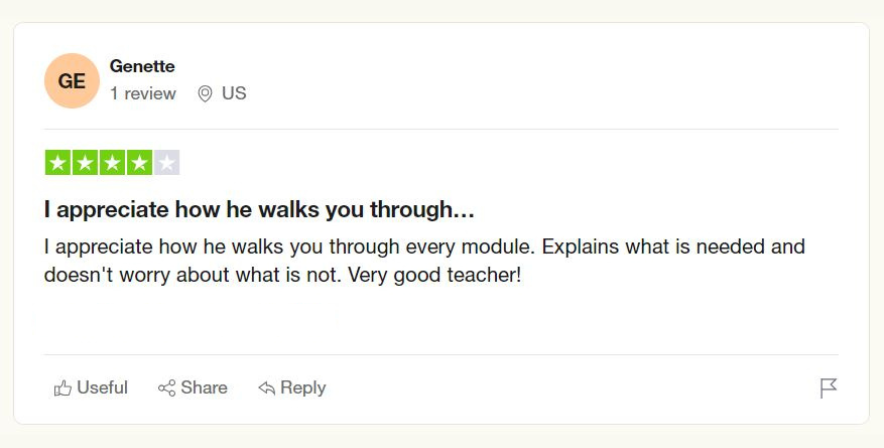
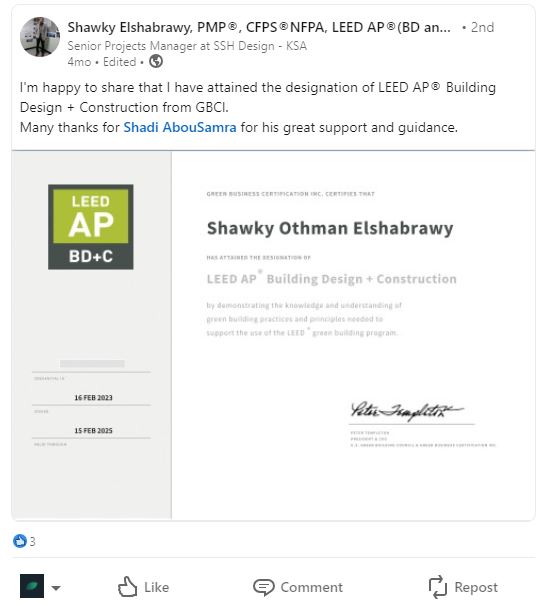

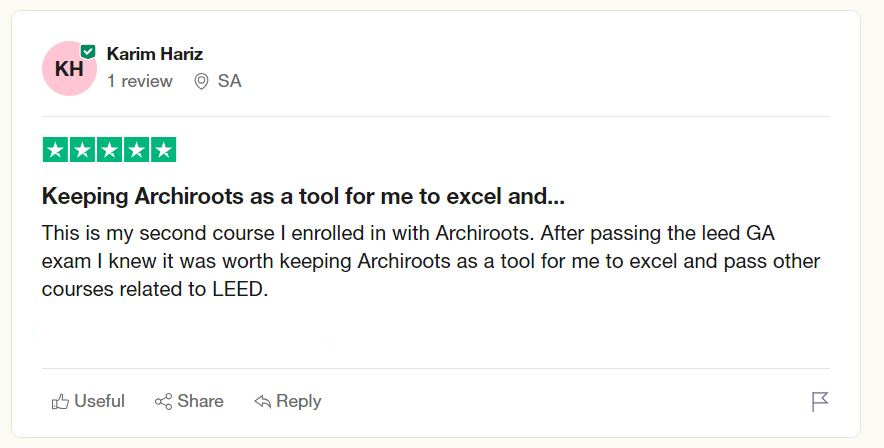






What is LEED AP Exam and Why You Must Earn it
A LEED AP credential can not only enhance your career and increase your salary but also position you as a steward of sustainable practices. Mentioned below are the most compelling reasons why you should consider becoming a LEED AP. Most of which can be a way to renew your LEED Green Associate or you can take on free LEED CE hours.
Sustainability is not just a buzzword; it’s a moral and practical imperative. Passing the LEED AP test allows you to play a pivotal role in championing sustainability within the built environment. It signifies your commitment to mitigating the adverse impacts of construction and real estate on our planet.
Sustainable building practices aim to reduce carbon emissions, conserve natural resources, and create healthier living and working spaces. Your expertise will help shape structures that are more energy-efficient, water-conscious, and environmentally responsible.

1. CAREER ADVANCEMENT
In today’s competitive job market, standing out from the crowd is essential. The LEED accreditation is like a spotlight on your resume, highlighting your commitment to sustainability and your expertise in sustainable building practices. Employers, clients, and colleagues recognize it as a symbol of your dedication to a more environmentally conscious world.
As a LEED AP, you’ll find doors opening to roles in green building consulting, sustainability management, project leadership, and more. You’ll be at the forefront of shaping the future of your industry, making meaningful contributions, and reaping the rewards of a career that aligns with your passion for sustainability.
2. MULTI-DISCIPLINARY RELEVANCE
Sustainability is not confined to a single profession or industry; it’s a cross-cutting concern that impacts all sectors. The beauty of the LEED AP certification is its versatility. It welcomes professionals from diverse backgrounds and disciplines to join the ranks of sustainability advocates.
Architects, engineers, project managers, interior designers, real estate experts, facility managers, and more can all find their niche within the LEED AP program. The specialization options within the LEED AP certification allow you to tailor your expertise to your specific field of interest. This means that no matter where you are in your career or what your professional background is, there’s a path for you to make a meaningful impact in sustainability
3. KNOWLEDGE ENRICHMENT
Pursuing a LEED AP certification is a journey of continuous learning and personal growth. It goes beyond textbook knowledge; it immerses you in the practical intricacies of green building and sustainable design. You’ll gain a profound understanding of not just what sustainability is but how to implement it in the real world.
This knowledge enrichment extends to various facets of sustainable construction, from selecting environmentally friendly materials to optimizing energy and water efficiency. You’ll be equipped with the ability to identify opportunities for sustainability improvements and the skills to implement them effectively. Your expertise will make you a valuable resource on any project team.
4. GLOBAL RECOGNITION
Sustainability knows no borders. It’s a global endeavor, and the LEED accreditation is a universal symbol of sustainable excellence. Whether you’re working in the heart of a bustling metropolis or on a remote project site, the principles of sustainable building apply everywhere.
The LEED AP certification is not confined to the United States; it’s a recognized standard worldwide. This global recognition means that your expertise is transferable across countries and continents. You can collaborate on international projects, influence global sustainability initiatives, and contribute to making the entire world a more sustainable place.
5. ENVIRONMENTAL IMPACT
The most compelling reason to become a LEED AP is the tangible environmental impact your work can achieve. Sustainable buildings have the power to mitigate climate change, conserve precious natural resources, and improve the well-being of occupants.
Green buildings are designed to be highly energy efficient, reducing greenhouse gas emissions associated with energy consumption. They incorporate sustainable building materials, renewable energy sources, such as solar panels and wind turbines, to further minimise their carbon footprint. Water-efficient fixtures and systems reduce water consumption, contributing to water conservation efforts.
Beyond environmental benefits, sustainable buildings also prioritise the health and comfort of occupants. They offer improved indoor air quality, access to natural light, and spaces designed to enhance well-being. As a LEED AP, you’ll play a vital role in ensuring that these benefits are realised, creating buildings that not only tread lightly on the planet but also provide a superior living and working experience for people.
LEED AP CERTIFICATION REQUIREMENTS
For you to even apply for a LEED AP exam, there is mainly 2 LEED AP certification requirements. First, it is essential that you must be over 18 years of age and the second requirement is to have a valid LEED Green Associate accreditation. Below is a LEED AP lookup at the other LEED AP certification requirements you must fulfil to take the LEED AP exam.
EDUCATION AND BACKGROUND
There is no background or professional requirement to take on the exam. Though it is typical and more of a must-have for professionals having a degree in a relevant field such as architecture, engineering, interior design, or a related discipline. Also years of experience is not a requirement, even fresh graduates or students are eligible to take on the exam.
LEED GREEN ASSOCIATE CREDENTIAL
Mainly the only real requirement to apply for a LEED AP certification is a valid non expired LEED Green Associate credential. It serves as the foundation for the LEED certification.
LEED PROJECT EXPERIENCE
As previously stated there is no job experience requirement or green building experience requirement and definitely no need to have experience on a LEED project. Though experience can surely help reduce the LEED AP exam preparation process. If no experience is provided it is recommended to have a proper LEED AP training course to smoothen the learning experience.
IS THE LEED AP WORTH IT?

The LEED AP BD+C is the most in-demand LEED certification out of the rest of the LEED AP specialties and is a highly sought-after green building certification that demonstrates expertise in sustainable design for new construction and major renovation construction.
A prestigious title for building professionals to earn. Just head to LinkedIn jobs or Indeed or Glassdoor or any job listing website just like the images above. When looking into any job requirement or qualification you will be surprised to see that LEED is either required or preferred in the building industry and LEED AP BD+C salaries prove to be higher than professionals without the LEED AP title.
Even companies are pushing their employees to acquire LEED. Either by losing their annual bonus if they don’t achieve it or requiring senior roles to be LEED accredited so they can win more projects. Whereas newcomers must be accredited or indicate they will be in a few months. Companies are currently advertising themselves with how many LEED accredited staff work at the company.
WHAT LEED AP STAND FOR?
LEED is an acronym that stands for Leadership in Energy and Environmental Design and the AP stands for Accredited Professional. As a general overview, the LEED AP stands for an accreditation that gives professionals credibility in the built environment when discussing green buildings and sustainability, opening doors to new opportunities.
The title demonstrates that a designer or builder understands how to achieve the LEED certification on a project, showcasing that green buildings are more than just a trend.
Earning the LEED AP does not have to be hard, it just needs proper guidance. Don’t waste your time, money, and effort with complicated books and study guides that are not really guides but reference books for consultants, not functioning as LEED AP exam prep programs.
It’s doable to go through the materials on your own, it’s not rocket science, it’s just not ideal. Why spend more time and money on thick reference books that are tailored for sustainability consultants to refer to when certifying a project. They include much more information than you actually need for the exam and can be complicated to understand without a LEED AP trainer.
It is advisable to take a simplified LEED AP course that brakes down the complicated content saving both time and cost from LEED AP BD+C study guides. As a starting point it is ideal to go through the LEED AP BD+C candidate handbook then this archiroots simplified training which includes a LEED AP BD+C pass rate of 100%.
WHAT DOES THE LEED AP BD+C EXAM COST?
Fees differ if one of the above is different. Companies with USGBC memberships offer discounts to their employees. Students take the LEED AP exam for 250$ and veterans can apply for the exam for free.
Also the LEED AP has 1 requirement which is a valid LEED Green Associate title. The the candidate has not yet earned the Green Associate, then there is an additional $250 to take the GA exam. It is also possible to take a combined LEED Green Associate and LEED AP exam together in one sitting for $550. The exam is 4 hours rather than separate 2 hour exams.

BECOME A LEED AP BD+C!

